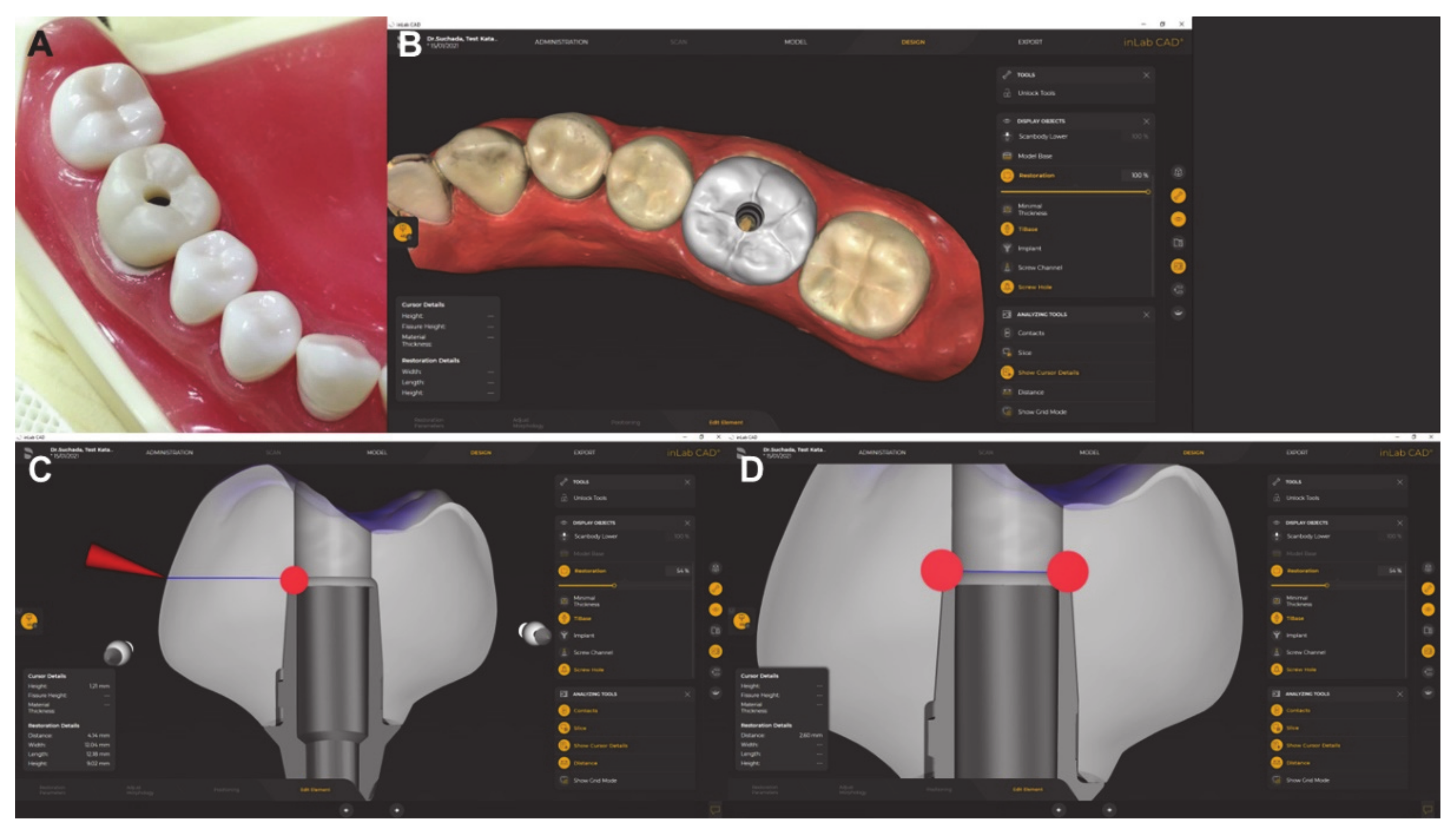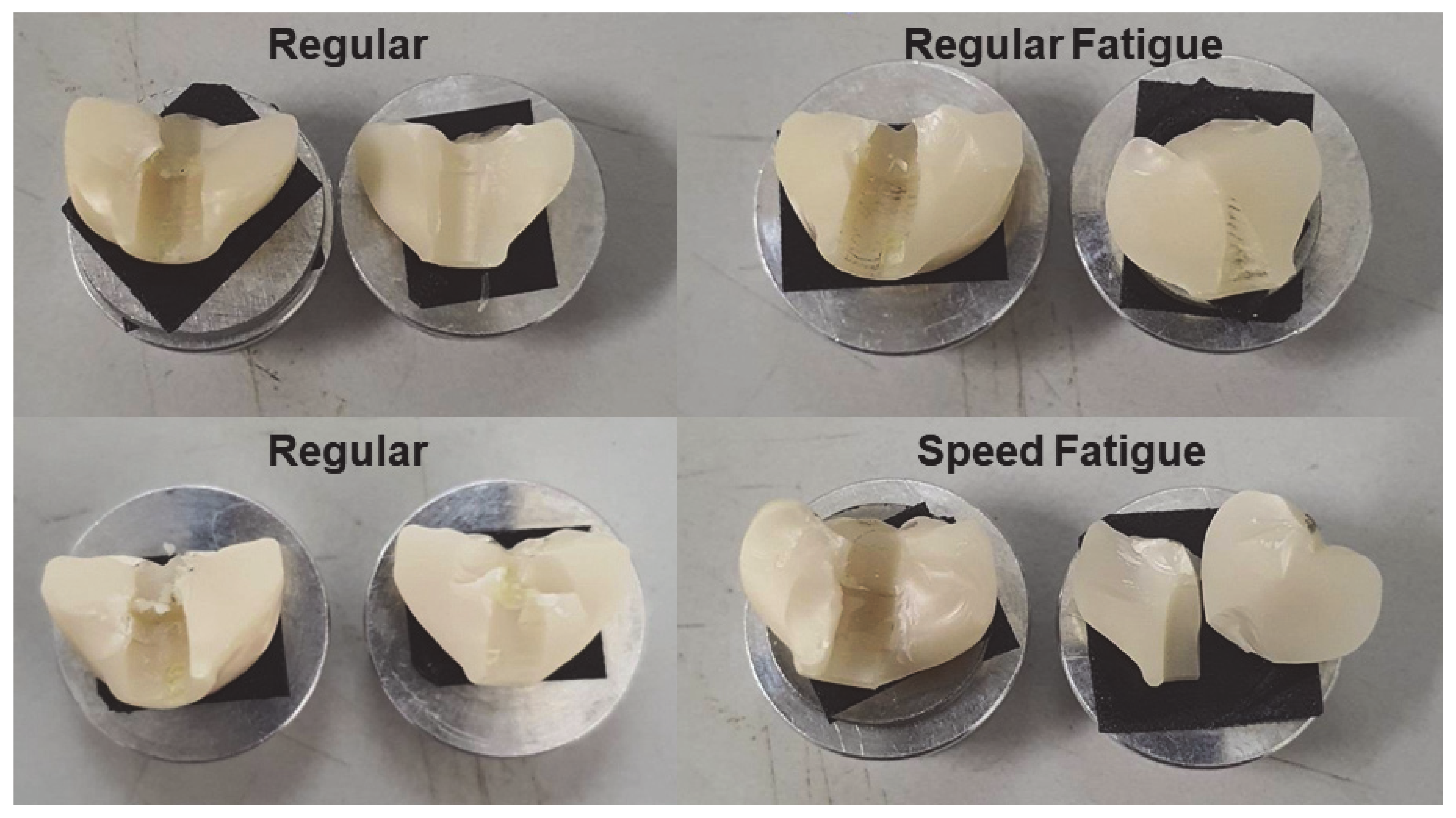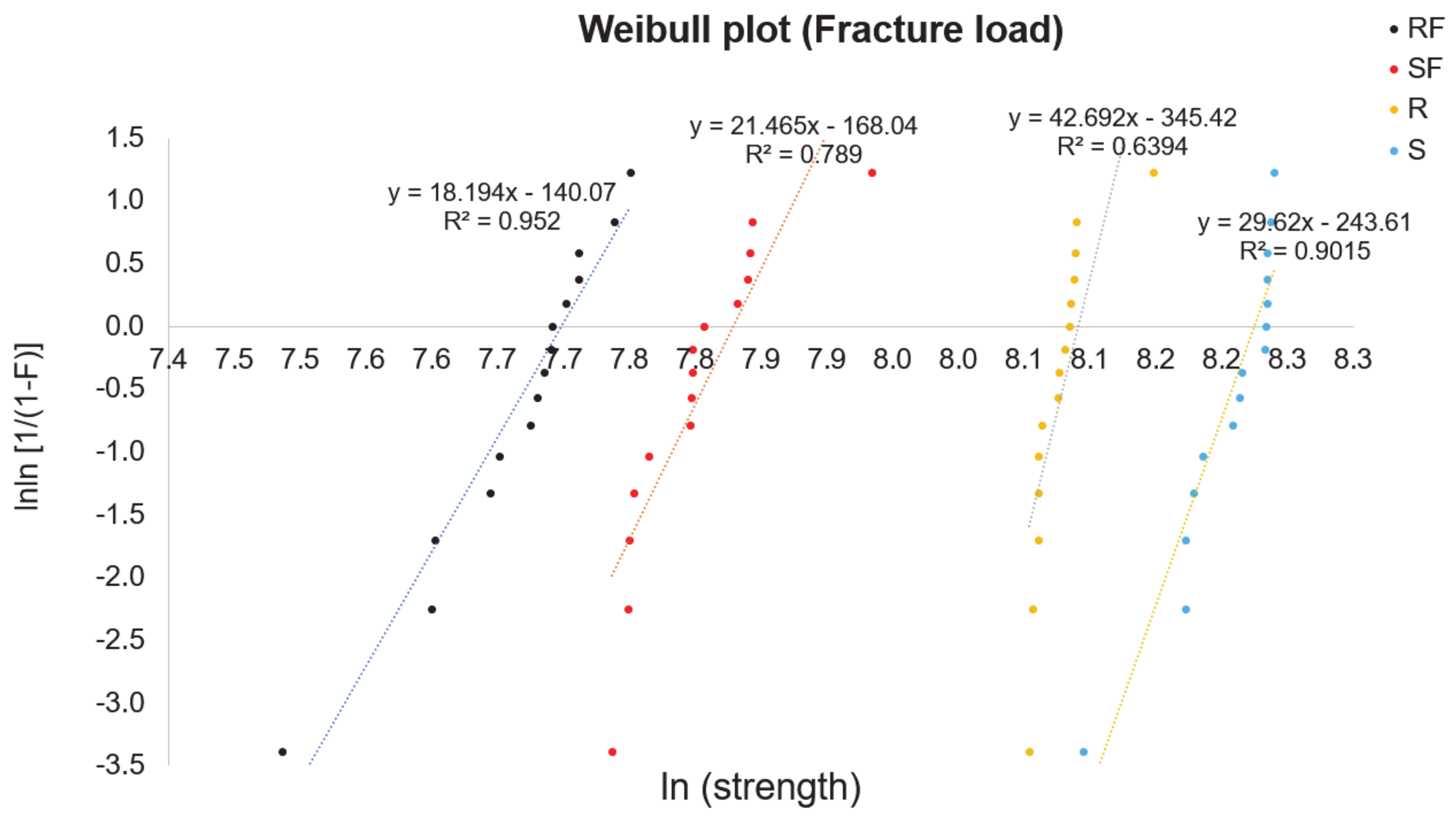Comparison of Regular and Speed Sintering on Low-Temperature Degradation and Fatigue Resistance of Translucent Zirconia Crowns for Implants: An In Vitro Study
Abstract
1. Introduction
2. Materials and Methods
2.1. Construction of Screw-Retained Zirconia Crowns
2.2. Cementation of Screw-Retained Zirconia Crowns
2.3. Cyclic Loading of Screw-Retained Zirconia Crowns
2.4. Load to Failure
2.5. Surface Characterization and Fractographic Analysis
2.6. Weibull’s Analysis
2.7. Statistical Analysis
3. Results
3.1. Fractographic Analysis
3.2. Load to Failure
4. Discussion
5. Conclusions
Author Contributions
Funding
Institutional Review Board Statement
Data Availability Statement
Conflicts of Interest
References
- Mayinger, F.; Buser, R.; Laier, M.; Schönhoff, L.M.; Kelch, M.; Hampe, R.; Stawarczyk, B. Impact of the material and sintering protocol, layer thickness, and thermomechanical aging on the two-body wear and fracture load of 4y-tzp crowns. Clin. Oral Investig. 2022, 26, 6617–6628. [Google Scholar] [CrossRef] [PubMed]
- Zhang, Y.; Lawn, B.R. Novel zirconia materials in dentistry. J. Dent. Res. 2018, 97, 140–147. [Google Scholar] [CrossRef] [PubMed]
- Jung, S.; Moser, M.M.; Kleinheinz, J.; Happe, A. Biocompatibility of lithium disilicate and zirconium oxide ceramics with different surface topographies for dental implant abutments. Int. J. Mol. Sci. 2021, 22, 7700. [Google Scholar] [CrossRef]
- Abhay, S.S.; Ganapathy, D.; Veeraiyan, D.N.; Ariga, P.; Heboyan, A.; Amornvit, P.; Rokaya, D.; Srimaneepong, V. Wear resistance, color stability and displacement resistance of milled peek crowns compared to zirconia crowns under stimulated chewing and high-performance aging. Polymers 2021, 13, 3761. [Google Scholar] [CrossRef] [PubMed]
- Kongkiatkamon, S.; Booranasophone, K.; Tongtaksin, A.; Kiatthanakorn, V.; Rokaya, D. Comparison of fracture load of the four translucent zirconia crowns. Molecules 2021, 26, 5308. [Google Scholar] [CrossRef] [PubMed]
- Heboyan, A.; Marya, A.; Syed, A.U.Y.; Khurshid, Z.; Zafar, M.S.; Rokaya, D.; Anastasyan, M. In vitro microscopic evaluation of metal-and zirconium- oxide-based crowns’ marginal fit. Pesqui. Bras. Odontopediatria Clín. Integr. 2022, 22, e210144. [Google Scholar] [CrossRef]
- Sailer, I.; Balmer, M.; Hüsler, J.; Hämmerle, C.H.F.; Känel, S.; Thoma, D.S. 10-year randomized trial (rct) of zirconia-ceramic and metal-ceramic fixed dental prostheses. J. Dent. 2018, 76, 32–39. [Google Scholar] [CrossRef]
- Heboyan, A.; Manrikyan, M.; Zafar, M.S.; Rokaya, D.; Nushikyan, R.; Vardanyan, I.; Vardanyan, A.; Khurshid, Z. Bacteriological evaluation of gingival crevicular fluid in teeth restored using fixed dental prostheses: An in vivo study. Int. J. Mol. Sci. 2021, 22, 5463. [Google Scholar] [CrossRef]
- Shin, H.; Ko, H.; Kim, M. Cytotoxicity and biocompatibility of zirconia (y-tzp) posts with various dental cements. Restor. Dent. Endod. 2016, 41, 167–175. [Google Scholar] [CrossRef]
- Kongkiatkamon, S.; Rokaya, D. Full digital workflow in the esthetic dental restoration. Case Rep. Dent. 2022, 2022, 8836068. [Google Scholar] [CrossRef]
- Humagain, M.; Rokaya, D. Integrating digital technologies in dentistry to enhance the clinical success. Kathmandu. Univ. Med. J. 2019, 17, 256–257. [Google Scholar]
- Abduo, J.; Lyons, K. Rationale for the use of cad/cam technology in implant prosthodontics. Int. J. Dent. 2013, 2013, 768121. [Google Scholar] [CrossRef] [PubMed]
- D’Souza, K.M.; Aras, M.A. Applications of cad/cam technology in dental implant planning and implant surgery. In Advances in Dental Implantology Using Nanomaterials and Allied Technology Applications; Chaughule, R.S., Dashaputra, R., Eds.; Springer International Publishing: Cham, Switzerland, 2021; pp. 247–286. [Google Scholar]
- Rokaya, D.; Kongkiatkamon, S.; Heboyan, A.; Dam, V.V.; Amornvit, P.; Khurshid, Z.; Srimaneepong, V.; Zafar, M.S. 3d-printed biomaterials in biomedical application. In Functional Biomaterials: Drug Delivery and Biomedical Applications; Jana, S., Jana, S., Eds.; Springer: Singapore, 2022; pp. 319–339. [Google Scholar]
- Elraggal, A.; Aboushelib, M.; Abdel Raheem, I.M.; Afifi, R.R. Effect of surface treatments on biaxial flexural strength, fatigue resistance, and fracture toughness of high versus low translucency zirconia. BMC Oral Health 2022, 22, 412. [Google Scholar] [CrossRef] [PubMed]
- Zhang, F.; Inokoshi, M.; Batuk, M.; Hadermann, J.; Naert, I.; Van Meerbeek, B.; Vleugels, J. Strength, toughness and aging stability of highly-translucent y-tzp ceramics for dental restorations. Dent. Mater. 2016, 32, e327–e337. [Google Scholar] [CrossRef]
- Baldissara, P.; Wandscher, V.F.; Marchionatti, A.M.E.; Parisi, C.; Monaco, C.; Ciocca, L. Translucency of ips e.Max and cubic zirconia monolithic crowns. J. Prosthet. Dent. 2018, 120, 269–275. [Google Scholar] [CrossRef]
- Kwon, S.J.; Lawson, N.C.; McLaren, E.E.; Nejat, A.H.; Burgess, J.O. Comparison of the mechanical properties of translucent zirconia and lithium disilicate. J. Prosthet. Dent. 2018, 120, 132–137. [Google Scholar] [CrossRef]
- Zhang, Y.; Lawn, B.R.; Rekow, E.D.; Thompson, V.P. Effect of sandblasting on the long-term performance of dental ceramics. J. Biomed. Mater. Res. B Appl. Biomater. 2004, 71, 381–386. [Google Scholar] [CrossRef]
- Liu, C.; Eser, A.; Albrecht, T.; Stournari, V.; Felder, M.; Heintze, S.; Broeckmann, C. Strength characterization and lifetime prediction of dental ceramic materials. Dent. Mater. 2021, 37, 94–105. [Google Scholar] [CrossRef]
- Kosmač, T.; Oblak, C.; Jevnikar, P.; Funduk, N.; Marion, L. The effect of surface grinding and sandblasting on flexural strength and reliability of y-tzp zirconia ceramic. Dent. Mater. 1999, 15, 426–433. [Google Scholar] [CrossRef]
- Guazzato, M.; Albakry, M.; Quach, L.; Swain, M.V. Influence of surface and heat treatments on the flexural strength of a glass-infiltrated alumina/zirconia-reinforced dental ceramic. Dent. Mater. 2005, 21, 454–463. [Google Scholar] [CrossRef]
- Reveron, H.; Fornabaio, M.; Palmero, P.; Fürderer, T.; Adolfsson, E.; Lughi, V.; Bonifacio, A.; Sergo, V.; Montanaro, L.; Chevalier, J. Towards long lasting zirconia-based composites for dental implants: Transformation induced plasticity and its consequence on ceramic reliability. Acta Biomater. 2017, 48, 423–432. [Google Scholar] [CrossRef]
- Mao, L.; Kaizer, M.R.; Zhao, M.; Guo, B.; Song, Y.F.; Zhang, Y. Graded ultra-translucent zirconia (5y-psz) for strength and functionalities. J. Dent. Res. 2018, 97, 1222–1228. [Google Scholar] [CrossRef] [PubMed]
- McLaren, E.A.; Maharishi, A.; White, S.N. Influence of yttria content and surface treatment on the strength of translucent zirconia materials. J. Prosthet. Dent. 2021, in press. [Google Scholar] [CrossRef] [PubMed]
- Nogueira, L.B.; Moura, C.D.; Francischone, C.E.; Valente, V.S.; Alencar, S.M.; Moura, W.L.; Soares Martins, G.A. Fracture strength of implant-supported ceramic crowns with customized zirconia abutments: Screw retained vs. Cement retained. J. Prosthodont. Off. J. Am. Coll. Prosthodont. 2016, 25, 49–53. [Google Scholar] [CrossRef] [PubMed]
- Inokoshi, M.; Shimizu, H.; Nozaki, K.; Takagaki, T.; Yoshihara, K.; Nagaoka, N.; Zhang, F.; Vleugels, J.; Van Meerbeek, B.; Minakuchi, S. Crystallographic and morphological analysis of sandblasted highly translucent dental zirconia. Dent. Mater. 2018, 34, 508–518. [Google Scholar] [CrossRef] [PubMed]
- Kongkiatkamon, S.; Peampring, C. Effect of speed sintering on low temperature degradation and biaxial flexural strength of 5y-tzp zirconia. Molecules 2022, 27, 5272. [Google Scholar] [CrossRef] [PubMed]
- Pang, Z.; Chughtai, A.; Sailer, I.; Zhang, Y. A fractographic study of clinically retrieved zirconia-ceramic and metal-ceramic fixed dental prostheses. Dent. Mater. 2015, 31, 1198–1206. [Google Scholar] [CrossRef]
- ISO 6872:2015; Dentistry–Ceramic Materials. International Standards Organization (ISO): Geneva, Switzerland, 2015; p. 28.
- Weibull, W. A statistical distribution function of wideapplicability. J. Appl. Mech. 1951, 103, 293–297. [Google Scholar] [CrossRef]
- Nemeth, N.N.; Gyekenyesi, J.P.; Jadaan, O.J. Lifetime Reliability Prediction of Ceramic Structures under Transient Thermomechanical Loads; NASA Center for Aerospace Information: Hanover, MD, USA, 2005; p. 212505. [Google Scholar]
- Pereira, G.K.R.; Guilardi, L.F.; Dapieve, K.S.; Kleverlaan, C.J.; Rippe, M.P.; Valandro, L.F. Mechanical reliability, fatigue strength and survival analysis of new polycrystalline translucent zirconia ceramics for monolithic restorations. J. Mech. Behav. Biomed. Mater. 2018, 85, 57–65. [Google Scholar] [CrossRef]
- Mayinger, F.; Pfefferle, R.; Reichert, A.; Stawarczyk, B. Impact of high-speed sintering of three-unit 3y-tzp and 4y-tzp fixed dental prostheses on fracture load with and without artificial aging. Int. J. Prosthodont. 2021, 34, 47–53. [Google Scholar] [CrossRef]
- Wiedenmann, F.; Pfefferle, R.; Reichert, A.; Jerman, E.; Stawarczyk, B. Impact of high-speed sintering, layer thickness and artificial aging on the fracture load and two-body wear of zirconia crowns. Dent. Mater. 2020, 36, 846–853. [Google Scholar] [CrossRef]
- Jerman, E.; Wiedenmann, F.; Eichberger, M.; Reichert, A.; Stawarczyk, B. Effect of high-speed sintering on the flexural strength of hydrothermal and thermo-mechanically aged zirconia materials. Dent. Mater. 2020, 36, 1144–1150. [Google Scholar] [CrossRef]
- Arcila, L.V.C.; Ramos, N.C.; Campos, T.M.B.; Dapieve, K.S.; Valandro, L.F.; de Melo, R.M.; Bottino, M.A. Mechanical behavior and microstructural characterization of different zirconia polycrystals in different thicknesses. J. Adv. Prosthodont. 2021, 13, 385–395. [Google Scholar] [CrossRef]
- Ordoñez Balladares, A.; Abad-Coronel, C.; Ramos, J.C.; Martín Biedma, B.J. Fracture resistance of sintered monolithic zirconia dioxide in different thermal units. Materials 2022, 15, 2478. [Google Scholar] [CrossRef]
- Prott, L.S.; Spitznagel, F.A.; Bonfante, E.A.; Malassa, M.A.; Gierthmuehlen, P.C. Monolithic zirconia crowns: Effect of thickness reduction on fatigue behavior and failure load. J. Adv. Prosthodont. 2021, 13, 269–280. [Google Scholar] [CrossRef]






| Composition | |
|---|---|
| ZrO2 + HfO2 | 88–93 wt.% |
| Y2O3 | 7–10 wt.% |
| Other oxides | 0–2 wt.% |
| Properties | |
| Flexural strength | 748 MPa |
| Translucency | 38% |
| Coefficient of thermal expansion | 9.8 ± 0.2 × 10−6 K−1 |
| Sintering | N | Mean (N) | Std. Deviation | Std. Error | Minimum | Maximum |
|---|---|---|---|---|---|---|
| Regular | 15 | 3223.60 | 76.11 | 19.65 | 3146.00 | 3456.00 |
| Regular fatigue | 15 | 2143.06 | 135.93 | 35.09 | 1783.00 | 2324.00 |
| Speed | 15 | 3664.46 | 140.90 | 36.38 | 3276.00 | 3787.00 |
| Speed fatigue | 15 | 2450.06 | 128.26 | 33.12 | 2290.00 | 2790.00 |
| (I) Groups | (J) Groups | Mean Difference (I-J) | p Value |
|---|---|---|---|
| Regular | Regular fatigue | 1080.53 | <0.001 * |
| Speed | −440.86 | <0.001 * | |
| Speed fatigue | 773.53 | <0.001 * | |
| Regular fatigue | Regular | −1080.53 | <0.001 * |
| Speed | −1521.40 * | <0.001 * | |
| Speed fatigue | −307.00 | <0.001 * | |
| Speed | Regular | 440.86 | <0.001 * |
| Regular fatigue | 1521.40 | <0.001 * | |
| Speed fatigue | 1214.40 | <0.001 * | |
| Speed fatigue | Regular | −773.53 | <0.001 * |
| Regular fatigue | 307.00 | <0.001 * | |
| Speed | −1214.40 | <0.001 * |
| Sintering Protocol | N | Characteristic Strength σo [MPa] | Coefficient of Determination R2 | Weibull Modulus m |
|---|---|---|---|---|
| Regular (R) | 15 | 3244 | 0.64 | 42.69 |
| Regular fatigue (RF) | 15 | 2190 | 0.95 | 18.19 |
| Speed (S) | 15 | 3765 | 0.90 | 29.62 |
| Speed fatigue (SF) | 15 | 2457 | 0.79 | 21.46 |
Publisher’s Note: MDPI stays neutral with regard to jurisdictional claims in published maps and institutional affiliations. |
© 2022 by the authors. Licensee MDPI, Basel, Switzerland. This article is an open access article distributed under the terms and conditions of the Creative Commons Attribution (CC BY) license (https://creativecommons.org/licenses/by/4.0/).
Share and Cite
Kongkiatkamon, S.; Peampring, C. Comparison of Regular and Speed Sintering on Low-Temperature Degradation and Fatigue Resistance of Translucent Zirconia Crowns for Implants: An In Vitro Study. J. Funct. Biomater. 2022, 13, 281. https://doi.org/10.3390/jfb13040281
Kongkiatkamon S, Peampring C. Comparison of Regular and Speed Sintering on Low-Temperature Degradation and Fatigue Resistance of Translucent Zirconia Crowns for Implants: An In Vitro Study. Journal of Functional Biomaterials. 2022; 13(4):281. https://doi.org/10.3390/jfb13040281
Chicago/Turabian StyleKongkiatkamon, Suchada, and Chaimongkon Peampring. 2022. "Comparison of Regular and Speed Sintering on Low-Temperature Degradation and Fatigue Resistance of Translucent Zirconia Crowns for Implants: An In Vitro Study" Journal of Functional Biomaterials 13, no. 4: 281. https://doi.org/10.3390/jfb13040281
APA StyleKongkiatkamon, S., & Peampring, C. (2022). Comparison of Regular and Speed Sintering on Low-Temperature Degradation and Fatigue Resistance of Translucent Zirconia Crowns for Implants: An In Vitro Study. Journal of Functional Biomaterials, 13(4), 281. https://doi.org/10.3390/jfb13040281







